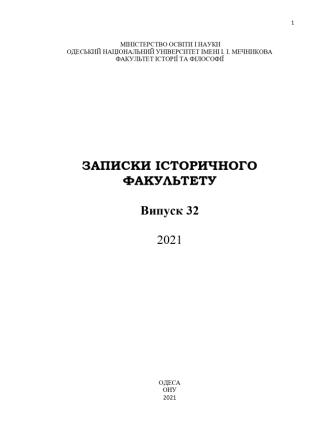ДО ПИТАННЯ ЩОДО ВІДОБРАЖЕННЯ РОЛІ РУМУНІЇ ТА ТРАНСНІСТРІЇ В ІСТОРІЇ СХІДНОЄВРОПЕЙСЬКИХ ЄВРЕЇВ У ПУБЛІКАЦІЯХ В АМЕРИКАНСЬКІЙ ПРЕСІ 1940-Х РР.
TO THE QUESTION ON REFLECTION OF ROMANIA AND TRANSNISTRIA SIGNIFICANCE FOR THE HISTORY OF EASTERN EUROPEAN JEWS IN THE AMERICAN PRESS PUBLICATIONS IN 1940 S
Author(s): Liudmyla NovikovaSubject(s): Media studies, Interwar Period (1920 - 1939), History of the Holocaust, History of Antisemitism
Published by: Видавництво «Одеський національний університет І. І. Мечникова»
Keywords: Eastern European Jews; Transnistria; Holocaust; Romania in the 1920–1940s; Jews in Bessarabia; Jews in Bukovina; Jews in Odessa;
Summary/Abstract: This article covers the content of information about the place of Romania in the 1920– 1940s. and Transnistria in the history of Eastern European Jews, which was published in predominantly English-language materials in a number of American newspapers in the 1940s, such as «Românul American», «The Southern Jewish Weekly», «Evening Star» and «Detroit Evening Times». The purpose of the study is to determine the structure of the newspaper narrative regarding the place of Romania in the 1920–1940s and Transnistria in the history of Eastern European Jews, contained in the mentioned newspaper publications. As a result of the study, a conditionally holistic information narrative on the significance of Romania and Transnistria in the history of Eastern European Jews in the 1920–1940s was reconstructed in publications of a number of American newspapers, which spread in mass opinion. The main components of this English-language narrative are following: in pre-war Romania was an increased influence of official actual anti-Semitism; this was of particular importance given that Transnistria was predominantly a zone of Romanian administration during World War II; the plight of Jews in Romania and Bukovina during the war; cases of nonJewish support for Jews; brutal deportations of the Jewish population from Romania, Bukovina, Bessarabia (sometimes also Moldavia, which regarding changes in the characteristics of Bessarabia and Bukovina) to Transnistria; domination of the atmosphere of fear of the possibility of deportation to Transnistria among the still undeported Jews; manipulation by the Romanian government of the Jewish population through this fear; the plight of Jews, the Holocaust in Transnistria; repatriation to Romania and migration to Palestine as the «historical homeland» of Jews deported during the war to Transnistria. According to some materials, this narrative had not only an exposing anti-Nazi purpose, not only appealed to the public support of Jews who had experienced repression, deportation and the Holocaust, but also had to serve to preserve the democratic worldview of the Romanian minority in the United States (most of the used publications were contained in the newspaper «Românul American»).
Journal: Записки історичного факультету
- Issue Year: 2021
- Issue No: 32
- Page Range: 93-113
- Page Count: 21
- Language: Ukrainian

